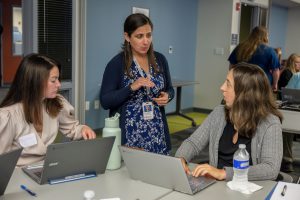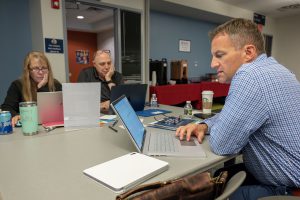 The Northeast Regional Information Center (NERIC) recently hosted “Building Strategic Capacity for Generative AI,” an essential summit designed to equip K-12 education leaders with the framework, tools, and training necessary to approach Generative AI thoughtfully and strategically.
The Northeast Regional Information Center (NERIC) recently hosted “Building Strategic Capacity for Generative AI,” an essential summit designed to equip K-12 education leaders with the framework, tools, and training necessary to approach Generative AI thoughtfully and strategically.
This initiative is part of a larger, collaborative project led by CoSN (Consortium for School Networking) and the Association of Educational Service Agencies (AESA), with support from State Educational Technology Directors Association (SETDA) and the American Association of School Administrators (AASA), aiming to build AI capacity across districts of all sizes, including under-resourced and rural areas.
The event highlighted the project’s goal of serving districts by helping them evaluate their readiness across seven key areas: leadership, operations, data, technology, security, legal considerations, and academic AI literacy. Grounded in the CoSN /CGCS K-12 Gen AI Maturity Tool, the training utilizes a scalable train-the-trainer model to guide participants in assessing current capabilities, identifying future goals, and creating actionable implementation plans.
 These AI District Leadership Action Summits are designed to support Superintendent-led executive leadership teams, moving them from initial AI exploration toward intentional implementation. Participants leave with a clear vision and a head start on a prioritized 6-12 month action plan that aligns Generative AI adoption with their district’s mission and long-term goals.
These AI District Leadership Action Summits are designed to support Superintendent-led executive leadership teams, moving them from initial AI exploration toward intentional implementation. Participants leave with a clear vision and a head start on a prioritized 6-12 month action plan that aligns Generative AI adoption with their district’s mission and long-term goals.
The rapid evolution of Generative AI was a central theme, as was the challenge of setting appropriate guidelines. Mark Place, Superintendent of the Middleburgh Central School District attended the event and shared the immediate impact of the discussions on his district’s internal planning.
“I think one of the things is, the questions that are being asked to then ask at a different level for our staff and then Board of Education too, what are we going to put in for our guardrails, what do we put in for policy?” Place asked.
He noted that the ability to interact with peers and experts during the summit helped solidify his projected approach.
“If we’re talking about the questions and being able to interact, then I can sort of get my response to be more concrete over time.”
The difficulty of anticipating AI’s future trajectory was a recurring point for leaders. Place emphasized this uncertainty and the critical need for peer collaboration.
“The pace at which things are happening is even beyond my ability to comprehend what’s next,” he said. “Trying to figure out, where do we go next? What are we doing for our staff to prepare for students to engage with AI? What is that going to look like in a year from now, five years from now? Which, most people can’t even predict six months from now. So that’s the challenge, I think.”
Ultimately, the event underscored that while keeping up with every new development in AI may require constant review and revision, the foundational policy questions are constant.
NERIC’s support through these summits helps district leaders move forward with confidence, ensuring their AI strategy is built on a strong, collaborative, and adaptable foundation.
